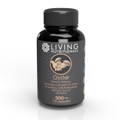Oyster

Latin Name
Total Polysaccharides %
Beta Glucans %
Starch
Mycilium or Fruiting Bodies?
Substrate
Extract Ratio
Sustainably Grown
Amount per Serving
What is Oyster Mushroom?
Oyster mushroom is a kind of fungus belonging to Pleurotaceae family, it is traditionally known as White rot fungi, Abalone, and tree oyster mushroom . Pleurotus species are industrially valuable mushrooms that are widely produced across the world. Among 40 Pleurotus species, Oyster mushrooms are the world’s third most popular grown mushroom species, after shiitake mushrooms. Pleurotus species are predominantly found in tropical forests and often grow on fallen branches, dead and decaying tree stumps, and wet logs [1].
Many scientists have conducted extensive study on the nutritional and therapeutic properties of Oyster Mushroom as it is well known for possessing three required properties from food which are nutrients, biological properties and taste. The existence of bioactive molecules, which have been identified from oyster mushroom fruiting bodies, is responsible for the health-promoting and medicinal actions [2]. The known bioactive compounds are β-Glucans, peptides and proteins, terpenes, fatty acid esters and polyphenols. Because of the presented bioactive substances, Oyster mushrooms demonstrate some important therapeutic activity including, reduce blood sugar, fights inflammations, enhance immunity system, protects liver, lowers blood pressure, prevents strokes and reduces risks of heart attacks. When compared to vegetables, Oyster mushrooms have a larger protein content, minerals such as sodium, calcium, iron, phosphorus, and potassium, and Vitamin C and B complex were also observed.
